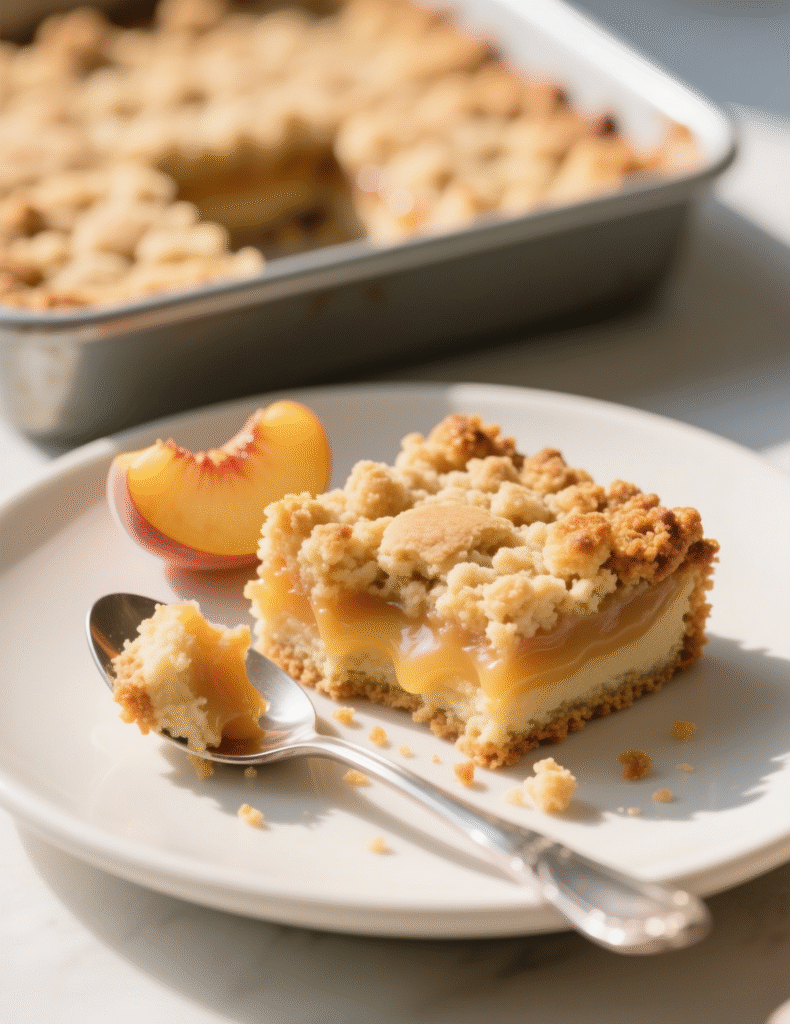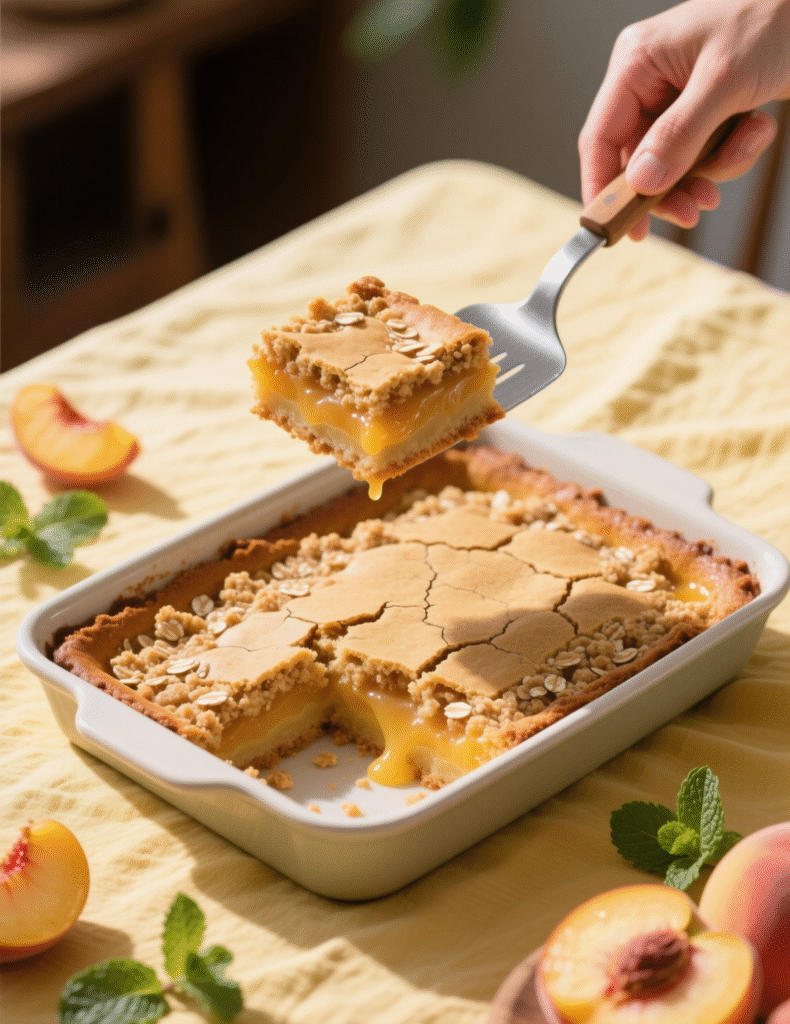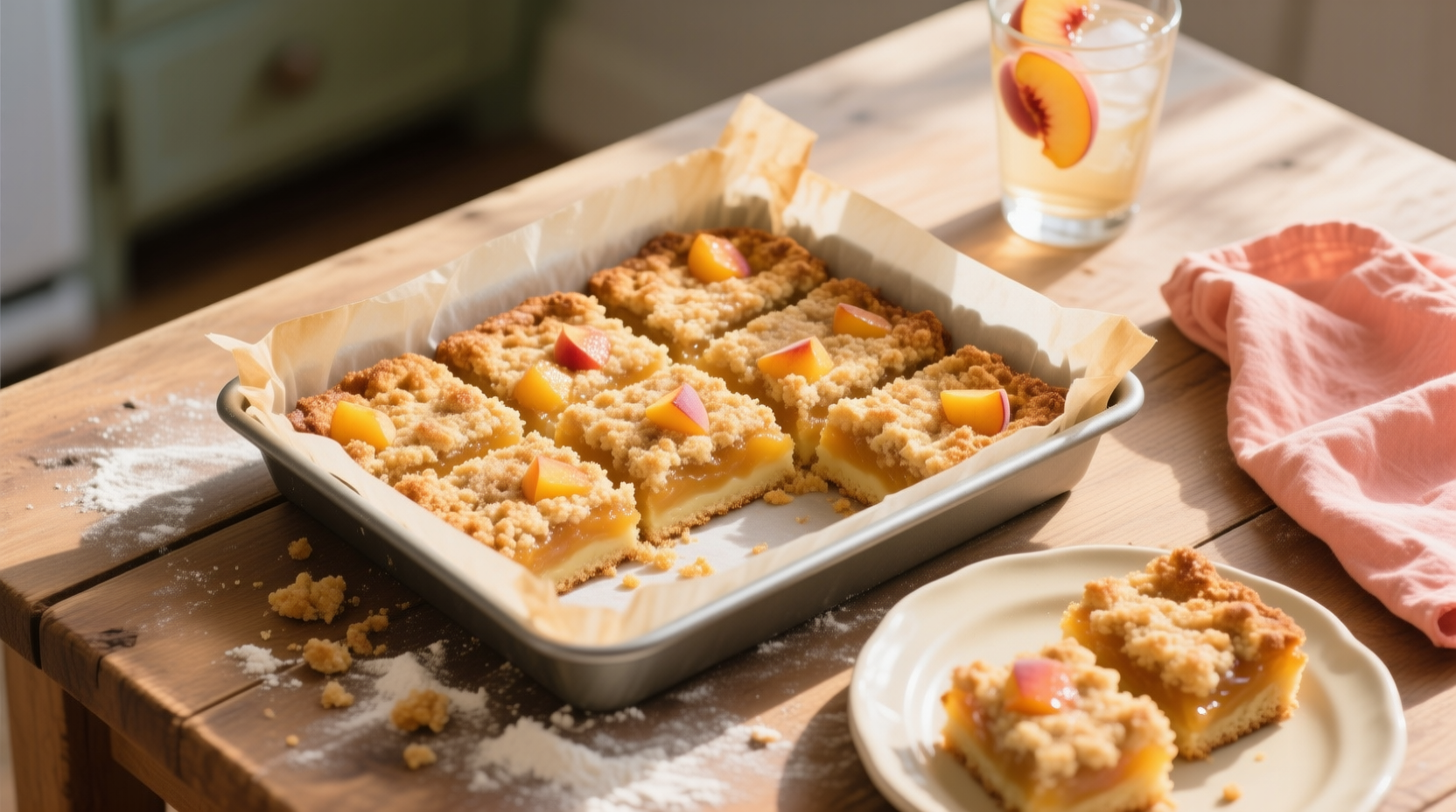There’s something quietly magical about a dessert that looks humble but delivers a punch of flavor and texture. Buttery Peach Crumb Bars with Creamy Filling fall in that camp. They straddle the line between rustic comfort food and bakery-level pastry. For professionals in the kitchen, this dessert is not only a lesson in balance but also in structure—the crumb, the fruit, and the cream layer all require precision if you want them to play well together. The goal is not just sweet satisfaction but controlled layering, where each bite tells the story you intended.
Why Peach Crumb Bars Deserve More Respect
Fruit bars are often underrated because they’re considered “homey.” But let’s look deeper. Peaches, with their high water content (about 89% water according to USDA data), are tricky in baked desserts. Too much juice and the crust sogs out; too little and you’re chewing something closer to leather. Professionals know that pectin, ripeness, and even the way you cut the fruit matters. Peach crumb bars, when done right, become a masterclass in managing moisture, crumb stability, and flavor contrast.
The creamy filling introduces a secondary challenge. It’s not cheesecake, but it mimics the idea. Cream cheese, when lightly sweetened and baked, creates a custard-like middle layer. That filling has to hold firm enough to slice but soft enough to give way under a fork. Any imbalance, and you’ve got mush or cracks—neither sells in a bakery display.
The Anatomy of a Perfect Crumb Bar
Every component in these bars serves a function. The crust is the anchor—it must be strong, buttery, and slightly crisp. Think of it as the stage. The creamy filling is the character that adds richness, a counterpoint to fruit acidity. Then comes the topping: crumb. Without crumb, the bars feel naked. With too much crumb, you overpower the peaches.
The best crumb has what I call the “pinch-and-clump” factor. If you pinch the mixture, it holds together lightly, but still crumbles apart when baked. Professional bakers often keep butter just cold enough so that when it melts in the oven, it creates air pockets, giving the topping that sandy yet tender bite.

Ingredient Breakdown: Going Beyond the Grocery List
Butter: Unsalted butter is non-negotiable here. Salted butter introduces inconsistency because salt levels vary between brands. Using unsalted lets you control seasoning exactly. You want it chilled before mixing—52°F is an ideal working temperature for creating crumb structure.
Flour: All-purpose works fine, but pastry flour can give you a more tender crumb. Gluten development is the enemy in crumb bars. The less gluten, the softer the bite. Professionals sometimes mix half all-purpose, half cake flour for that perfect texture.
Peaches: Fresh, ripe peaches bring the best flavor. But frozen peaches are a viable alternative if you handle them correctly. Always thaw and drain well, otherwise excess liquid will bleed into the filling. A quick toss with cornstarch can help bind juices.
Cream Cheese: Room temperature cream cheese blends smooth. Cold cream cheese will give you lumps, which no professional should tolerate. Stabilizers in commercial cream cheese brands help prevent cracks, which is why large bakeries prefer them.
Sugar: You need to layer sugar thoughtfully. A touch in the crust, more in the cream filling, and just enough with the peaches to enhance, not mask, their flavor. Too much sugar and you lose the fruit.
Spices: Cinnamon is traditional, but nutmeg or cardamom can elevate the profile. Professionals in modern pastry kitchens often experiment with unexpected pairings—white pepper with peach can be shocking but elegant.
Step-By-Step Method: Precision Meets Creativity
Step 1: Building the Base
Mix flour, sugar, and salt, then cut in cold butter until it resembles coarse crumbs. Press two-thirds into a lined pan. Pre-bake at 350°F for 12 minutes. This par-bake prevents soggy bottoms. Skipping this step is amateur mistake number one.
Step 2: The Creamy Middle
Beat cream cheese, sugar, vanilla, and egg until smooth. Pour over the pre-baked crust. This layer should spread evenly but not too thick. Professionals sometimes add a tablespoon of sour cream for tang and softer texture.
Step 3: Fruit Layer
Toss sliced peaches with a tablespoon of cornstarch, sugar, and lemon juice. Lay them gently over the cream filling. Avoid dumping fruit directly, or it will sink. Think of it as arranging tiles—you want coverage without overcrowding.
Step 4: The Crumb Topping
Mix reserved crust mixture with oats or chopped nuts for texture. Sprinkle generously but leave gaps so peaches peek through. Bake for 35–40 minutes, until golden brown and set. Cooling is critical—slice too soon, and you get a molten mess.
Troubleshooting and Professional Tips
- Soggy Bottom Crust: If your peaches release too much liquid, consider a quick stovetop pre-cook to evaporate some water. This also concentrates the flavor.
- Cracks in Filling: Overbaking cream cheese causes cracks. Pull bars when the center is just set but slightly wobbly. Residual heat will finish the job.
- Crumb Too Dry: This usually means butter wasn’t cold enough or flour ratio too high. Add a teaspoon of melted butter mid-mix to adjust.
- Uneven Bake: Commercial convection ovens run hotter and can brown topping too fast. Shield with foil halfway through if needed.

Variations for Professionals
Bars are versatile, and peaches aren’t the only option. Apricots bring tartness, blueberries add depth, and plums give a winey complexity. A bakery menu can rotate fruit seasonally. Imagine a late-summer peach version, followed by cranberry crumb bars in fall.
Adding herbs is another direction. Thyme with peach creates a savory twist. Lavender adds floral depth, though it can overpower if used carelessly. For a modern patisserie, a peach-basil crumb bar could sit comfortably alongside high-end tarts.
The Business Side: Why These Bars Sell
Bars like these are efficient. They cut cleanly, stack well in displays, and offer strong profit margins. According to a 2022 bakery industry report, handheld desserts outsell plated ones by 37% in grab-and-go markets. Crumb bars check every box: portable, comforting, scalable.
From a cost perspective, peaches in season are inexpensive. The base ingredients—butter, flour, sugar, cream cheese—are pantry staples. Production-wise, one large batch can yield 24 servings with minimal labor. For small bakeries, this kind of recipe is gold.
Nutrition and Modern Tweaks
These bars aren’t diet food, but professionals are often asked for lighter options. You can reduce sugar by 15% without compromising structure. Replacing part of the cream cheese with Greek yogurt cuts fat while maintaining creaminess. Whole wheat pastry flour in the crust adds fiber and a nutty undertone.
Gluten-free versions are very possible too. A blend of almond flour and oat flour can mimic crumb texture. But you’ll need xanthan gum for stability, otherwise bars collapse when sliced.
Common Misconceptions
One common myth is that canned peaches work just as well as fresh. They don’t. Their texture is mushy, and syrup makes bars cloyingly sweet. Another misconception is that crumb bars are “easy.” They’re simple in concept, but execution separates amateur from pro.
Another mistaken belief: chilling is optional. No—it’s essential. Cooling allows the filling to firm up. Professionals often refrigerate overnight before slicing for perfectly sharp edges.
Emerging Trends Around Fruit Bars
There’s a growing trend toward nostalgic desserts with modern twists. Peach crumb bars fit neatly into that movement. Bakeries are pairing classic fruit bars with artisanal ice creams, or plating them with sauces for upscale service.
Food media shows a spike in search trends for “fruit crumb bar recipe” over the past two years. Google Trends highlights increased interest in seasonal fruit desserts, particularly during summer peaks. This suggests demand isn’t fading but growing.
Final Thoughts
Buttery Peach Crumb Bars with Creamy Filling might look casual, but they demand professional-level precision. Every step—from par-baking the crust to balancing peach moisture—is a chance to show skill. For chefs and bakers, these bars are a reminder: elegance doesn’t always come in glossy finishes. Sometimes it hides in layers of butter, fruit, and cream, waiting for that perfect bite.
Bake them with intent, slice with patience, and serve knowing you’ve mastered the art of simplicity done perfectly. That’s the kind of dessert that not only feeds but teaches.
FAQs
What are buttery peach crumb bars made of?
They’re made with a buttery shortbread crust, creamy filling, fresh peach slices, and a crumbly topping.
Can I use canned or frozen peaches?
Fresh peaches are best, but drained canned or thawed frozen peaches can work if moisture is controlled.
Is the creamy filling like cheesecake?
Yes, it’s a light, tangy cheesecake-like filling made with cream cheese, yogurt, and an egg.
Can I make these bars gluten-free?
Yes, substitute the flour with a gluten-free baking blend and adjust texture as needed.
Do buttery peach crumb bars need to be refrigerated?
Yes, because of the creamy filling, they should be stored chilled for freshness and safety.
How long do peach crumb bars last?
Stored in the fridge, they stay fresh for about 4–5 days in an airtight container.
Can I freeze peach crumb bars?
Yes, wrap tightly and freeze for up to 2 months; thaw in the fridge before serving.
What kind of yogurt works best in the filling?
Plain Greek yogurt or sour cream works best for creaminess and a slight tang.
Why is my crumb topping too hard or dry?
It was likely overmixed or had too little butter; mix lightly and keep it crumbly.
Should I peel the peaches before baking?
Peeling is optional, but preferred for a smoother texture and better presentation.

Mariana is a passionate home cook who creates delicious, easy-to-follow recipes for busy people. From energizing breakfasts to satisfying dinners and indulgent desserts, her dishes are designed to fuel both your body and hustle.
When she’s not in the kitchen, she’s exploring new flavors and dreaming up her next recipe to share with the Foodie Hustle community.

